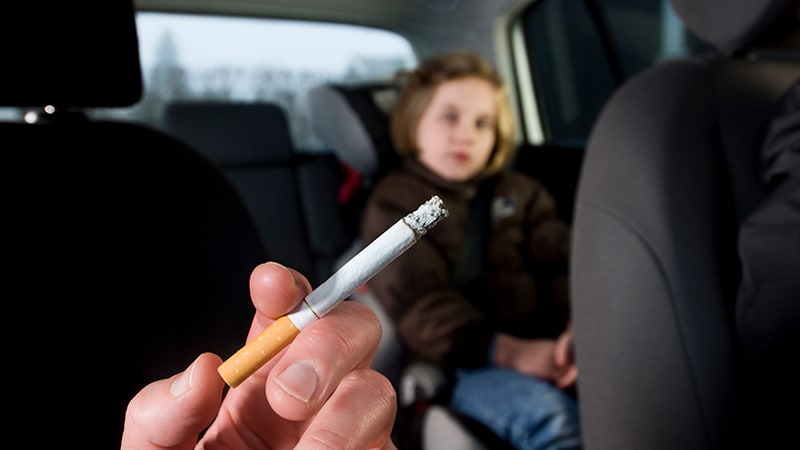Secondhand smoke exposure in both childhood and adulthood is associated with an increased risk of rheumatoid arthritis in women, according to a study presented at the annual European Congress of Rheumatology.
“These results suggest that smoking by-products, whether actively or passively inhaled or absorbed, could generate autoimmunity, at least towards antigens involved in rheumatoid arthritis pathogenesis,” according to Yann Nguyen, MD, MPH, of the Center for Research in Epidemiology and Population Health at the University of Paris-Saclay in Villejuif and of Beaujon Hospital at the University of Paris in Clichy, France.
“In addition, the age at rheumatoid arthritis onset seemed to be lower among women exposed to passive smoking in childhood, as if autoimmunity was triggered a long time before,” Nguyen told Medscape Medical News. “We thus believe that passive smoking should be avoided, especially among women at risk of rheumatoid arthritis.”
Previous research has already repeatedly implicated smoking as a risk factor for rheumatoid arthritis positive for anticitrullinated protein antibodies (ACPA), especially in those who have the HLA-DRB1-shared epitope (SE) alleles, Nguyen explained to attendees. This study looked at whether exposure to others’ smoke had any similar associations.
The researchers relied on the French prospective cohort study known as E3N-EPIC (Etude Epidémiologique auprès de femmes de la Mutuelle Générale de l’Education Nationale), which is designed to examine potential associations between environmental factors and chronic disease. Of the 98,995 healthy French women the longitudinal study has tracked since 1990, this study included 79,806 participants with an average age of 49. A total of 698 women developed rheumatoid arthritis during the study an average of 11.7 years after baseline.
Exposure to secondhand smoke, or passive smoking, in childhood was defined as spending several hours a day in a smoky room as a child, based on participants’ self-report. Adult exposure to passive smoking referred to women’s self-report of spending at least 1 hour a day around actively smoking adults. Researchers further stratified participants according to whether they currently smoke, have never smoked, or used to smoke. Additional covariates in the fully adjusted models included body mass index and educational level.
About one in seven of the women (13.5%) reported exposure to childhood passive smoking, and just over half (53.6%) reported passive smoking exposure as adults. Overall, 58.9% of participants had secondhand exposure in adulthood or childhood, and 8.25% had both.
A positive association existed between childhood exposure and rheumatoid arthritis in the unadjusted and adjusted models. In the fully adjusted model, the risk of rheumatoid arthritis was 1.24 times greater overall for those exposed to secondhand smoke in childhood compared to those with no exposure. The risk was even greater, however, among women who had never smoked (hazard ratio [HR], 1.42), and the association was not statistically significant in women who had ever smoked.
Similarly, risk of rheumatoid arthritis was greater among those women reporting exposure to passive smoking in adulthood in the unadjusted and adjusted models (HR, 1.19 after adjustment). Once again, women who had never smoked had a modestly higher increased risk (HR, 1.27) if they had secondhand smoke exposure in adulthood, but no statistically significant association existed for women who were current or former smokers.
“Although not impressive (20% to 40% increase), the risk of developing rheumatoid arthritis if exposed to secondhand smoke, either in childhood or adulthood, exists,” Loreto Carmona, MD, PhD, chair of the EULAR scientific program committee and scientific director of the Institute for Musculoskeletal Health in Madrid, Spain, told Medscape Medical News. “Furthermore, it makes sense from a biological perspective, as rheumatoid arthritis frequently starts in the lung before it hits the joints. This study supports advocacy for smoke-free environments for musculoskeletal health.”
Although research had previously shown the association between active smoking and rheumatoid arthritis, these new findings suggest clinicians need to emphasize to their patients this additional negative effect from smoking.
“Providers should inform their patients on the risk of developing rheumatoid arthritis for their children being increased already for the genetic component of the disease but also in case the children would be exposed to passive smoking even in childhood,” Hendrik Schulze-Koops, MD, PhD, head of the division of rheumatology at Ludwig Maximilian University of Munich in Germany, told Medscape Medical News. “Rheumatoid arthritis is not the only consequence of passive smoking and — as severe as it might be — probably not the most dramatic. But it is bad enough to avoid risks wherever possible. Passive smoking is avoidable — do not get your children in a situation where they are exposed.”
Nguyen, Carmona, and Schulze-Koops have reported no relevant financial relationships.
EULAR 2021. Abstract OP0012. Presented June 2, 2021.
Tara Haelle is an independent science journalist based in Texas who writes about medical research. Find her at @tarahaelle
Follow Medscape on Facebook, Twitter, Instagram, and YouTube.
